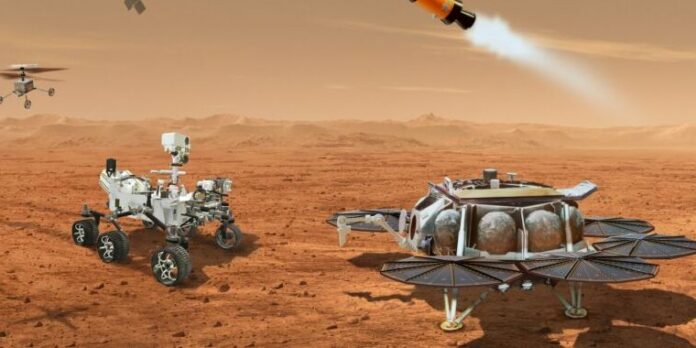NASA/JPL-Caltech
NASA’s $11 billion plan to robotically bring rock samples from Mars back to Earth is too expensive and will take too long, the agency’s administrator said Monday, so officials are tasking government and private sector engineers to come up with a better plan.
The agency’s decision on how to move forward with the Mars Sample Return (MSR) program follows an independent review last year that found ballooning costs and delays threatened the mission’s viability. The effort would likely cost NASA between $8 billion and $11 billion, and the launch would be delayed at least two years until 2030, with samples getting back to Earth a few years later, the review board concluded.
But that’s not the whole story. Like all federal agencies, NASA faces new spending restrictions imposed by the Fiscal Responsibility Act, a bipartisan budget deal struck last year between the White House and congressional Republicans. With these new budget headwinds, NASA officials determined the agency’s plan for Mars Sample Return would not get specimens from the red planet back to Earth until 2040.
One of the primary goals of NASA’s Perseverance rover, driving around Mars since 2021, is to collect and catalog more than 30 samples of Martian rocket, sediment, and air for return to Earth by a future mission. Perseverance is sealing these specimens in cigar-size titanium tubes, and collectively, they will total roughly half a kilogram in mass.
Returning pristine specimens from Mars to Earth for analysis in ground-based labs has been a top priority for the planetary science community’s decadal survey process. But getting those samples back has turned out to be a lot more challenging than NASA thought.
“The bottom line is that $11 billion is too expensive, and not returning samples until 2040 is unacceptably too long,” NASA Administrator Bill Nelson told reporters Monday.
Getting in gear
So NASA is shaking up the Mars Sample Return program. The preexisting plan came together over the last seven years, with refinements from engineers at NASA’s Jet Propulsion Laboratory, the institution charged with managing the effort.
The most recent iteration of the Mars Sample Return mission involves two launches. One would take place in 2030 with a European spacecraft that will orbit Mars and wait for the second mission—the responsibility of NASA—to depart Earth in 2035 with a Sample Retrieval Lander (SRL). The second launch would involve a Mars Ascent Vehicle (MAV), the rocket necessary to launch samples off the red planet and into space.
The lander would deliver the MAV to the Martian surface, and the Perseverance rover, already on Mars, will deliver sealed tubes of rock and soil specimens into a container for the trip back to Earth. The MAV would then launch the material into orbit around Mars, where the European-built Earth Return Orbiter would rendezvous with the sample container and pick it up for the journey home.
These launches were previously scheduled to occur two years apart in the late 2020s, but those target dates are no longer attainable with the current plan and budget, officials said Monday. Stretching out the two launches over a five-year span will spread out expenditures on the MSR program to fit within the agency’s projected budget without “cannibalizing” NASA’s other planetary science projects, like the Dragonfly mission to explore Saturn’s moon Titan.
The most recent plan unveiled Monday would also remove two helicopters from the Sample Retrieval Lander. These helicopters, which could have picked up sample tubes and delivered them to the pod that would return them to Earth, were supposed to be based on NASA’s Ingenuity helicopter successfully demonstrated on Mars with the Perseverance rover. Instead, the updated plan would rely entirely on Perseverance to hand off sample tubes to the Mars Ascent Vehicle.
There are also a few other changes to NASA’s MSR architecture, including replacing solar arrays on the Sample Retrieval Lander with a nuclear power generator. This would improve the lander’s reliability and provide better thermal conditions for the MAV, according to Sandra Connelly, deputy head of NASA’s science mission directorate.
However, this architecture is pretty much dead on arrival.


